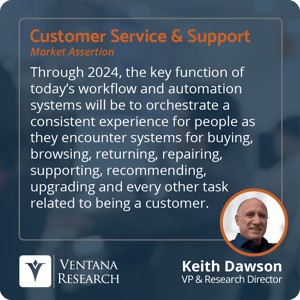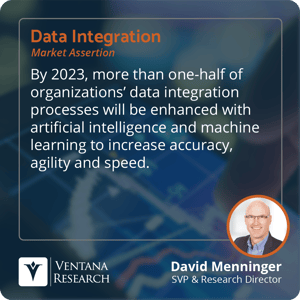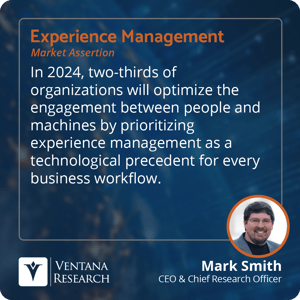Any organization that relies heavily on a large labor force looks to automation to reduce costs, and contact centers are no exception. They handle interactions at such large scale that almost any effort to automate some part of the process can deliver measurable efficiencies. Two factors have ratcheted up attention on automating customer experience workflows: the dramatic expansion of digital interaction channels, and the development of artificial intelligence and machine learning tools to facilitate workflow deployment.
Many organizations are taking the opportunity afforded by the pandemic to rethink and reconfigure contact center operations. Foremost is the way agents are deployed at home or in centers, along with technologies to manage them. Also important is the acceleration of cloud-based systems to replace traditional on-premises routing systems and expand capabilities into new areas.
 Automation has also been the beneficiary of a new awareness of the power (and amount) of contact center interaction data, and how it can be used alongside other organizational data resources. Much of the development of a broad CX posture (as opposed to a narrower contact center posture) comes from recognition that customers are “touched” by other participants at different moments in their journey. Wherever customers are in their life cycle, they are generating data. We assert that through 2024, the key function of today’s workflow and automation systems will be to orchestrate a consistent experience for people as they encounter systems for buying, browsing, returning, repairing, supporting, recommending, upgrading and every other task related to being a customer. And this applies to agents as much as to customers.
Automation has also been the beneficiary of a new awareness of the power (and amount) of contact center interaction data, and how it can be used alongside other organizational data resources. Much of the development of a broad CX posture (as opposed to a narrower contact center posture) comes from recognition that customers are “touched” by other participants at different moments in their journey. Wherever customers are in their life cycle, they are generating data. We assert that through 2024, the key function of today’s workflow and automation systems will be to orchestrate a consistent experience for people as they encounter systems for buying, browsing, returning, repairing, supporting, recommending, upgrading and every other task related to being a customer. And this applies to agents as much as to customers.
Self-service has been a test bed for automation systems, beginning with the way rudimentary interactive voice response uses decision-tree logic to create abstract templates for routing or information extraction by customers. Self-service automation really comes into its own, however, when it incorporates intelligent technology that learns or adapts based on circumstances, and interacts conversationally.
Automation and intelligence have elevated self-service interaction by making it both more personalized and open-ended. Intelligent virtual agents are several evolutionary steps beyond the standard touch-tone or speech-enabled IVR most contact centers use, and step into the realm of digital self-service using machines to assist in the interactions. Self-service exists on a technological spectrum, ranging from those old-school IVRs to basic chatbots, real intelligent agents for customers, and applications of that same technology to agent guidance. The technology and use cases are evolving so quickly that there aren’t hard and fast boundaries between these tools as market segments. Rather, they all co-exist within technology portfolios of vendors, ready to be cherry-picked and deployed based on the comfort level of an organization’s buyers and their perception of what their customers prefer.
IVAs are an example of how self-service tools are being improved through AI/ML. What distinguishes an intelligent virtual agent from an IVR is its ability to learn from experience and to swerve topically as the customer moves from one issue or question to another. No longer confined to tree-based logical structures, modern virtual agents are an important element in the attempt to use self-service interactions as moments of leverage — moments when a business can capture extended data about the customer and context, and either provide a better experience as a result or turn a service interaction into a sales opportunity.
AI-powered chatbots provide customers with a broader palette of self-service options, including the ability to purchase directly, to schedule calls or appointments, or to extract information about products, deliveries or prices. This encourages specialization of chatbots by customer segment and vertical market, and in general, they have shown positive results in reducing the number of interactions that have to be handled by agents.
Acceptance of the chatbot model for self-service opens the door to automating how agents themselves interact with those processes and data requests. If there is an automated system that has been trained on the kinds of interactions customers pursue, it makes sense to put the same automation underneath the agents’ workflow as well. This segues to using AI to provide real-time guidance to agents during interactions, and to knitting together processes that once would have required an interaction to be handed off from one person (or system) to another. An automated workflow transforms an agent from a processing machine into more of a concierge, helping a customer navigate multiple actions and ensuring that the human touch is available.
AI-based automation also strengthens connections between disparate back-office systems, and the people who use them.
The challenge for contact centers, then, is complexity. Automation isn’t magic – it has to be developed and tested alongside existing workflows that may or may not be automated. It requires a level of data and process management expertise that encompasses multiple stakeholders and resources throughout the organization, but especially in IT. It also requires contact center managers and buyers to be familiar with a new generation of technologies that aren’t always part of the core operational toolkit: customer data platforms, for example, and journey management tools, to name just two.
 Vendors have wrapped automation and AI together in their products. This makes sense, as the use cases for one overlap considerably with the other. Some are trying to make automation design easier with graphical tools that let operations teams drag and drop actions onto a template that links systems and provides clear pathways for information or actions based on triggers. This puts tremendous power in the hands of workflow designers, who can exert a very fine degree of control over complex pathways that would otherwise have required intense training and coaching for agents to master. The result is often fewer errors, less repetitive data entry by agents, and higher overall satisfaction measured among agents.
Vendors have wrapped automation and AI together in their products. This makes sense, as the use cases for one overlap considerably with the other. Some are trying to make automation design easier with graphical tools that let operations teams drag and drop actions onto a template that links systems and provides clear pathways for information or actions based on triggers. This puts tremendous power in the hands of workflow designers, who can exert a very fine degree of control over complex pathways that would otherwise have required intense training and coaching for agents to master. The result is often fewer errors, less repetitive data entry by agents, and higher overall satisfaction measured among agents.
Ventana Research has asserted that by 2023, more than one-half of organizations’ data integration processes will be enhanced with artificial intelligence and machine learning to increase accuracy, agility and speed. We also assert that in 2024, two-thirds of organizations will optimize the engagement between people and machines by prioritizing experience management as a technological precedent for every business workflow.
 Taken together, these trends suggest that planners are honing in on automated workflows across their organizations as they look to technology to ensure that tasks are replicable, measurable and accountable no matter where they originate. It also suggests that the combination of AI, automation and process analysis will be high on the list of priorities for buyers in multiple CX roles. And, from the point of view of many buyers, this period of post-pandemic transition offers an opportunity to review parts of the technology stack that may be neglected or outdated.
Taken together, these trends suggest that planners are honing in on automated workflows across their organizations as they look to technology to ensure that tasks are replicable, measurable and accountable no matter where they originate. It also suggests that the combination of AI, automation and process analysis will be high on the list of priorities for buyers in multiple CX roles. And, from the point of view of many buyers, this period of post-pandemic transition offers an opportunity to review parts of the technology stack that may be neglected or outdated.
Organizations that are investing in CX should look beyond the buzzwords and work with vendors that prioritize solid data integrations, which should be a prerequisite for any process work that crosses departments. Buyers should also try to implement automation without widespread digital transformation projects. Many vendors have developed methods of injecting stronger automation capabilities into existing CX toolsets, keeping in mind that disruptive overhauls are not possible in critical, customer-facing environments.
It has become clear that customers now expect experiences that are much more nuanced and productive than the old-style web visit or agented phone call. That puts the onus on buyers to audit and fully understand the processes that are already in place, especially how they interact with (or don’t interact with) other departments’ systems and processes.
For further insight into the role of AI in contact center automation, see these recent Analyst Perspectives:
Regards,
Keith Dawson


 Automation has also been the beneficiary of a new awareness of the power (and amount) of contact center interaction data, and how it can be used alongside other organizational data resources. Much of the development of a broad CX posture (as opposed to a narrower contact center posture) comes from recognition that customers are “touched” by other participants at different moments in their journey. Wherever customers are in their life cycle, they are generating data. We assert that through 2024, the key function of today’s workflow and automation systems will be to orchestrate a consistent experience for people as they encounter systems for buying, browsing, returning, repairing, supporting, recommending, upgrading and every other task related to being a customer. And this applies to agents as much as to customers.
Automation has also been the beneficiary of a new awareness of the power (and amount) of contact center interaction data, and how it can be used alongside other organizational data resources. Much of the development of a broad CX posture (as opposed to a narrower contact center posture) comes from recognition that customers are “touched” by other participants at different moments in their journey. Wherever customers are in their life cycle, they are generating data. We assert that through 2024, the key function of today’s workflow and automation systems will be to orchestrate a consistent experience for people as they encounter systems for buying, browsing, returning, repairing, supporting, recommending, upgrading and every other task related to being a customer. And this applies to agents as much as to customers. Vendors have wrapped automation and AI together in their products. This makes sense, as the use cases for one overlap considerably with the other. Some are trying to make automation design easier with graphical tools that let operations teams drag and drop actions onto a template that links systems and provides clear pathways for information or actions based on triggers. This puts tremendous power in the hands of workflow designers, who can exert a very fine degree of control over complex pathways that would otherwise have required intense training and coaching for agents to master. The result is often fewer errors, less repetitive data entry by agents, and higher overall satisfaction measured among agents.
Vendors have wrapped automation and AI together in their products. This makes sense, as the use cases for one overlap considerably with the other. Some are trying to make automation design easier with graphical tools that let operations teams drag and drop actions onto a template that links systems and provides clear pathways for information or actions based on triggers. This puts tremendous power in the hands of workflow designers, who can exert a very fine degree of control over complex pathways that would otherwise have required intense training and coaching for agents to master. The result is often fewer errors, less repetitive data entry by agents, and higher overall satisfaction measured among agents. Taken together, these trends suggest that planners are honing in on automated workflows across their organizations as they look to technology to ensure that tasks are replicable, measurable and accountable no matter where they originate. It also suggests that the combination of AI, automation and process analysis will be high on the list of priorities for buyers in multiple CX roles. And, from the point of view of many buyers, this period of post-pandemic transition offers an opportunity to review parts of the technology stack that may be neglected or outdated.
Taken together, these trends suggest that planners are honing in on automated workflows across their organizations as they look to technology to ensure that tasks are replicable, measurable and accountable no matter where they originate. It also suggests that the combination of AI, automation and process analysis will be high on the list of priorities for buyers in multiple CX roles. And, from the point of view of many buyers, this period of post-pandemic transition offers an opportunity to review parts of the technology stack that may be neglected or outdated.








